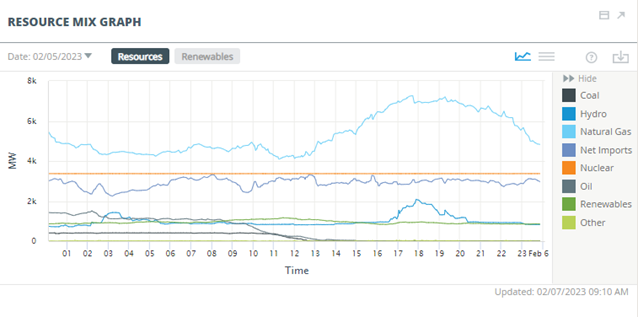Market Update | 2/8/2023
Last week the news in New England focused on the pending frigid cold expected over the weekend. There were many unknowns about how energy prices and the grid would react to the arctic blast. In a recent market update, we cautioned that planned outages, demand response events, and possibly very high pricing could occur. Fortunately, as we review the impact of the arctic blast this week, we see what transpired, and it was much better than expected.
The Impact of the Early February Artic Blast
The arctic blast was brief, moving into New England on Friday, February 3, 2022, during the day and clearing out Sunday, February 5, 2022. Although short-lived, it had all the ingredients to create significant problems, including sub-zero temperatures and high winds. During the early morning hours of Saturday, Boston dipped to -10° Fahrenheit, the coldest temperature since 1957. The Mount Washington Observatory in New Hampshire hit a record-setting wind chill of -108° Fahrenheit, the highest in US history, and tied the actual temperature record at the observatory of -47° Fahrenheit set in 1934. Unlike the near-rolling blackouts experienced during Christmas Eve 2022, Independent System Operator-New England (ISO-NE), (responsible for keeping electricity flowing across the six New England states), was able to operate under normal conditions through this past weekend.
During the peak energy demand on Friday and Saturday, which occurred in the evening between 5:00 and 6:00 PM on both days (Figure 1), ISO-NE relied heavily on fossil fuels (oil and natural gas) for electricity generation (Figure 2). The most significant difference from Christmas Eve 2022 was the availability of natural gas for the duration of the cold, allowing the natural gas generators to operate. When the cold moved out on Sunday, production from oil plants dropped to near zero (Figure 3) by the afternoon.
The grid operated under normal conditions during the brief arctic blast, but will it withstand longer cold snaps? Unfortunately, we may not know that answer this winter. Although relatively high energy prices averaged 13 cents per kWh on Friday and 28 cents per kWh on Saturday, they were lower than expected; based on December 24, 2022, prices which averaged 49 cents per kWh.
Are we Ready for Electrification?
Twenty years ago, nuclear power generated more baseload power, and natural gas was more of a dispatch fuel. With the retirement of many nuclear power plants, natural gas has become the base fuel, with renewable energy sources acting as a dispatchable source of electricity and oil filling in during extreme weather demands. Nationwide long-term goals focus on replacing technologies that use fossil fuels (coal, oil, and natural gas) with ones that run on electricity from renewable sources, a process referred to as electrification. However, this past weekend indicated that electrification would take time.
Traditional renewables like solar and wind are dispatchable resources and require the sun and wind, respectively. Nuclear power, particularly small modular reactors (SMR) plants, provide flexibility. SMR reactors, advanced nuclear reactors with a power capacity of up to 300 MW(e) per unit, can be used as both a primary and dispatchable resource. While expensive to build, these plants would be an ideal carbon-free source.
Looking Ahead
Changes are required to support the grid during extreme weather events and as electrification expands. As more electric vehicles, heat pumps, solar, and wind power are added to the grid, critical updates to power lines must occur to deliver on these demands. In the past few years, battery storage has become more efficient, reducing strain on the grid and the power supply mix. As a result, battery storage must be an integral part of the renewable future.
For the foreseeable future, the grid cannot function without fossil fuels during normal operation, let alone during extreme weather events. With the long-term goal of electrification, the switch from fossil fuels to 100% renewable power, this past weekend reminded us just how much work still needs to occur to achieve that goal.



Connect with the Freedom Energy team for more information or to discuss your energy options.







Connect With Us